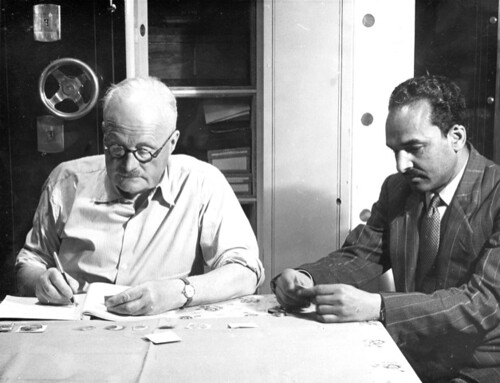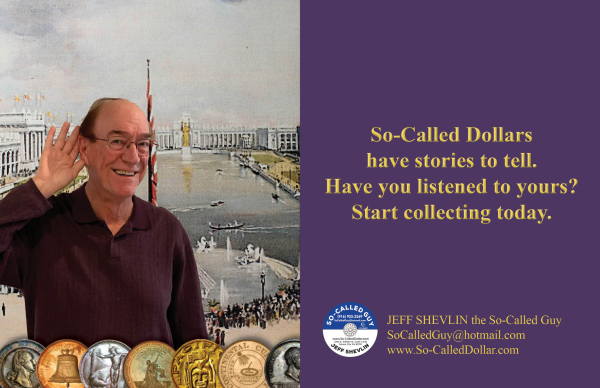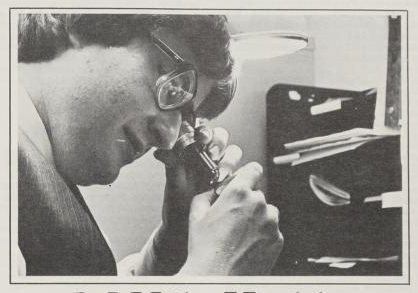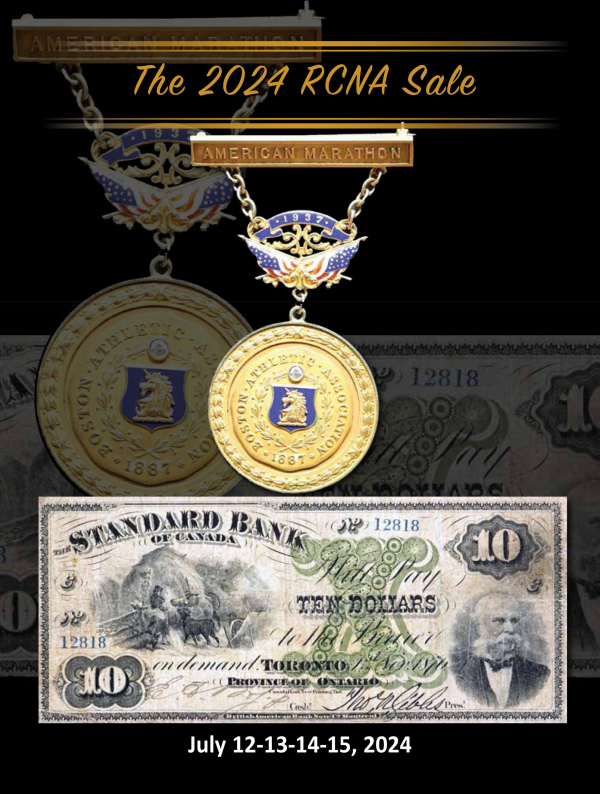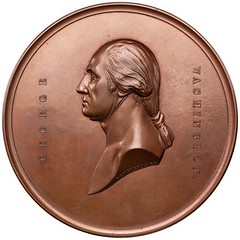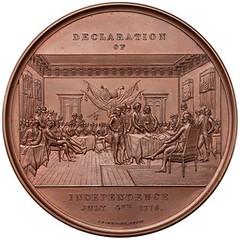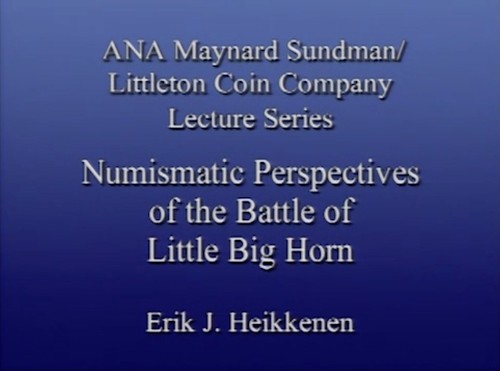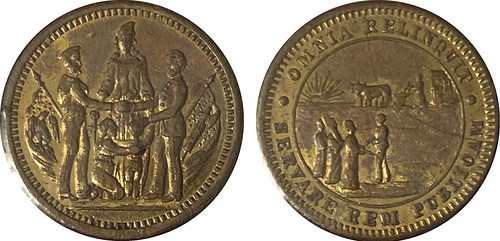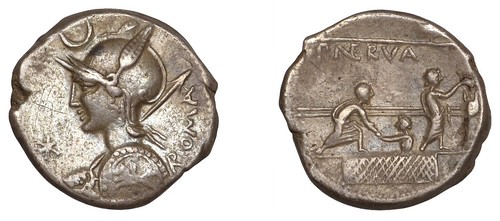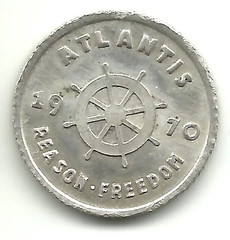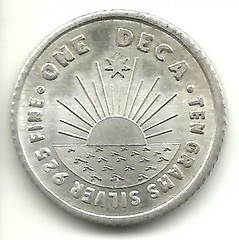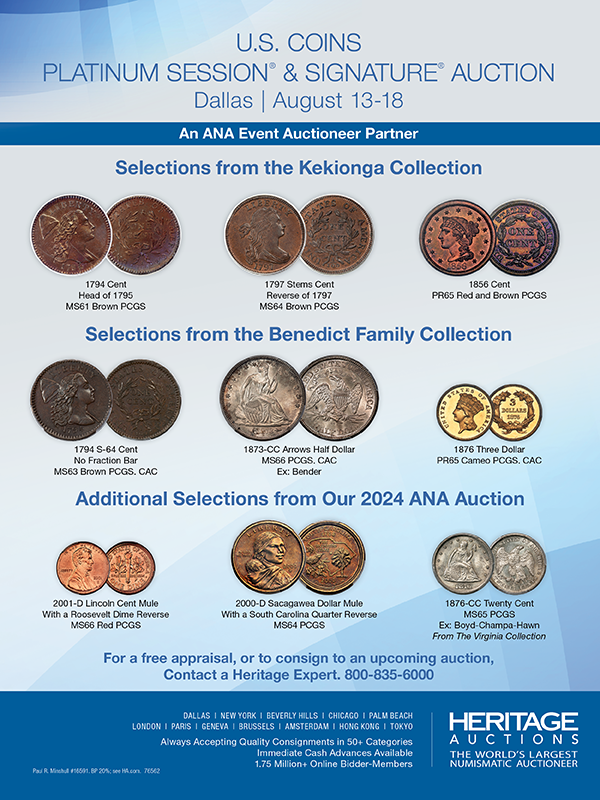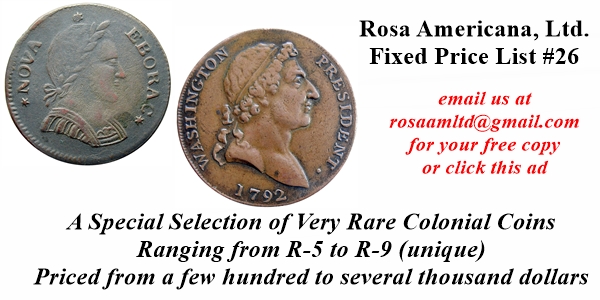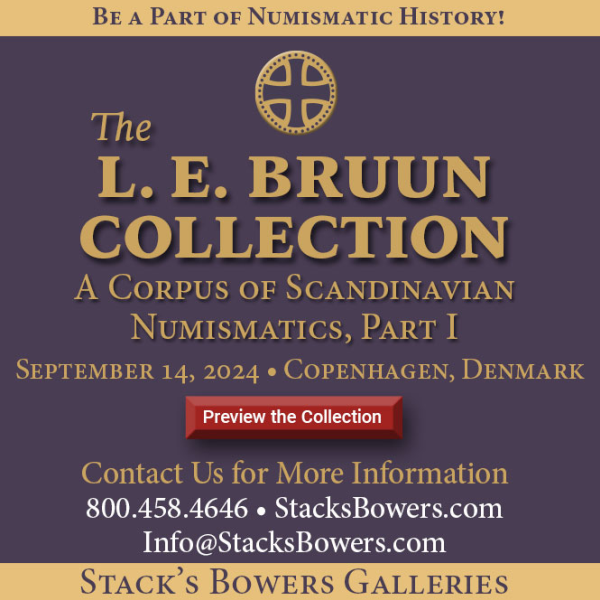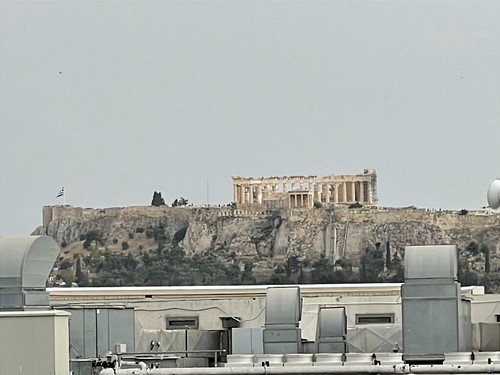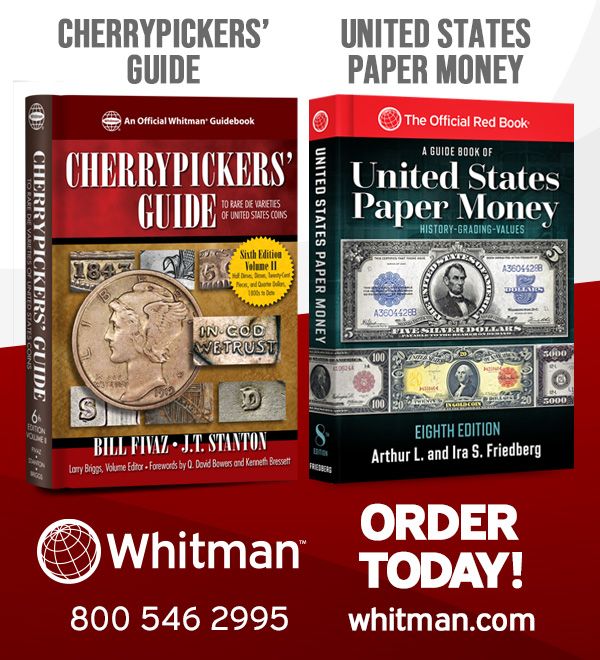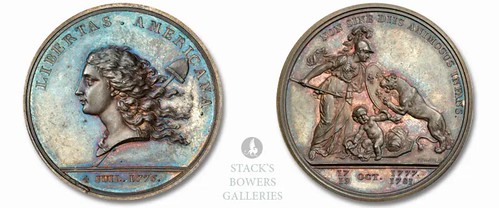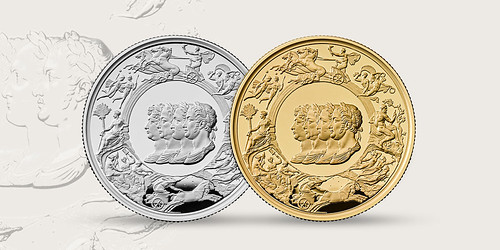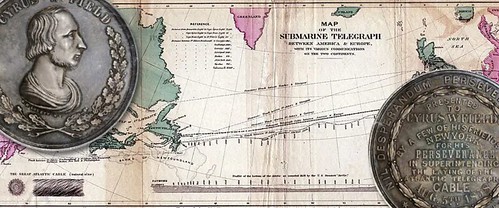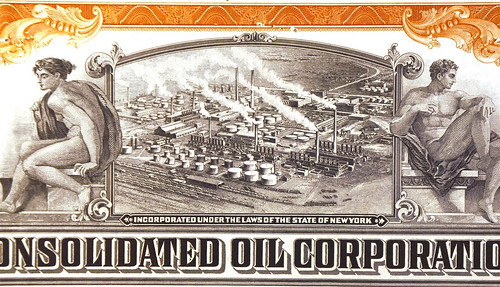
Visit our NBS Sponsors



About UsThe Numismatic Bibliomania Society is a non-profit association devoted to the study and enjoyment of numismatic literature. For more information please see our web site at coinbooks.org SubscriptionsThose wishing to become new E-Sylum subscribers (or wishing to Unsubscribe) can go to the following web page link MembershipThere is a membership application available on the web site Membership Application To join, print the application and return it with your check to the address printed on the application. Print/Digital membership is $40 to addresses in the U.S., and $60 elsewhere. A digital-only membership is available for $25. For those without web access, write to: Jeff Dickerson, Treasurer AsylumFor Asylum mailing address changes and other membership questions, contact Jeff at this email address: treasurer@coinbooks.org SubmissionsTo submit items for publication in The E-Sylum, write to the Editor at this address: whomren@gmail.com BUY THE BOOK BEFORE THE COINSale CalendarWatch here for updates! |
- WAYNE'S WORDS: THE E-SYLUM JUNE 30, 2024
- NEW BOOK: THE LONDON MINT, 2ND ED.
- NEW BOOK: NUMISMATIC LIBRARY OF SARAH SOPHIA BANKS
- WILLIAM MICHAEL HINKLE (1953-2024)
- C. C. WRIGHT DECLARATION OF INDEPENDENCE MEDALS
- VIDEO: NUMISMATICS OF LITTLE BIG HORN
- CINCINNATI GAR MEMBERSHIP BADGE
- NOTES FROM E-SYLUM READERS: JUNE 30, 2024
- VOTING ON COINS
- OPERATION ATLANTIS ONE DECA COIN
- VOCABULARY TERM: PORTRAIT MEDAL
- WHO WAS W. L. SHAW?
- STAN KESSELMAN INTERVIEW, PART TWO
- SARAH SOPHIA BANKS
- ANA HONORS NUMISMATIC ROLE MODELS
- DISPLAYS AT THE 2024 WORLD'S FAIR OF MONEY
- MIKE MARKOWITZ VISITS GREECE
- ANCIENT COINS FEATURED IN ROBINSON AUCTION
- WAYNE'S NUMISMATIC LITERATURE RESULTS
- A SILVER LIBERTAS AMERICANA MEDAL
- PISTRUCCI'S WATERLOO MEDAL
- AUGUSTUS SAGE'S CYRUS FIELD MEDAL
- FASCINATED BY OLD STOCK CERTIFICATES
- A VENDING MACHINE FOR MONEY
- LOOSE CHANGE: JUNE 30, 2024
Content presented in The E-Sylum is not necessarily researched or independently fact-checked, and views expressed do not necessarily represent those of the Numismatic Bibliomania Society.
WAYNE'S WORDS: THE E-SYLUM JUNE 30, 2024
 Thank you for reading The E-Sylum. If you enjoy it, please send me the email addresses of friends you think may enjoy it as well and I'll send them a subscription. Contact me at whomren@gmail.com anytime regarding your subscription, or questions, comments or suggestions about our content.
Thank you for reading The E-Sylum. If you enjoy it, please send me the email addresses of friends you think may enjoy it as well and I'll send them a subscription. Contact me at whomren@gmail.com anytime regarding your subscription, or questions, comments or suggestions about our content.
NOTE FOR THIS WEEK: I'll be traveling July 3-11, but my assistant Garrett Ziss will finalize the July 7th issue. While I'll still check email occasionally, PLEASE INCLUDE Garrett ( gzcbhd453@gmail.com) on correspondence this week and we'll do our best to pull together the issue as usual.
This week we open with two new books, an obituary, updates from the Newman Numismatic Portal, notes from readers, and more.
Other topics this week include Sarah Sophia Banks, Charles Cushing Wright, voting on coins, Operation Atlantis, portrait medals, W. L. Shaw, the Numismatic Museum of Athens, auction previews, some Kolbe & Fanning Sale 170 results, the Waterloo medal, scripophily, and ATMs.
To learn more about the London Mint of Constantius and Constantine, Mike Hinkle, Rick Snow, Declaration of Independence medals, GAR membership badges, cataloguing the Farouk sale, the one Deca silver coin, a 1933 double eagle, Sage's Cyrus Field medal, and risqué stock certificate vignettes, read on. Have a great week, everyone!
Wayne Homren
Editor, The E-Sylum
THE BOOK BAZARRE
NEW BOOK: THE LONDON MINT, 2ND ED.
Hugh Cloke writes:
"Spink has just posted the publication notice for the new edition of Lee Toone's and my The London Mint of Constantius and Constantine. This is the second of the three books to be celebrated at the York conference in July. The first book is Eleanor Ghey's study of Tetrarchic hoards. The third book is Sam Moorehead's upcoming volume of Roman Imperial Coinage on Carausius. That book will not be available by the July conference date."
 The London Mint of Constantius and Constantine, Second Edition
The London Mint of Constantius and Constantine, Second Edition
by Hubert J Cloke and Lee Toone, with Adrian B Marsden
£75.00
Hardback, jacketed, 297 x 210mm, 360 pages
This new edition of LMCC remains the comprehensive catalogue and survey of the coinage of the London mint from AD 296, when Constantius I recaptured Britain from the usurper, Allectus, to its closure in AD 325 when his son and successor, Constantine I, began to shift his power base to the East. LMCC II continues the authors' earlier expansion and revision of the London portions of Volumes VI and VII of The Roman Imperial Coinage by incorporating new types discovered since 2015 and expanding the census tables based on the population totals from several major new hoards. As Sam Moorhead notes in his foreword to this second edition, this catalogue is now recognised as the standard reference work on the London mint coins of this period and is used by both the British Museum and the Portable Antiquities Scheme when cataloguing these coins.
NEW BOOK: NUMISMATIC LIBRARY OF SARAH SOPHIA BANKS
A new book published by the Royal Mint Museum examines the numismatic library of famed collector Sarah Sophia Banks. See an article elsewhere in this issue for more about the woman and he collection. -Editor
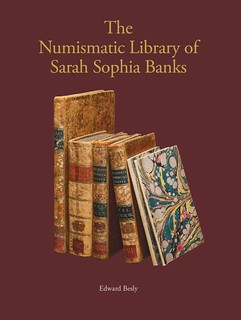 The Numismatic Library of Sarah Sophia Banks
The Numismatic Library of Sarah Sophia Banks
by Edward Besly
Hardback, jacketed, 180 pages, 290 x 220mm
Sarah Sophia Banks (1744-1818) was a distinguished collector and numismatist. With the help of her librarian, Jonas Dryander, she built an important library of numismatic books, both new and antiquarian, notable particularly for covering medieval and what were then modern coinages, rather than those of ancient Greece and Rome; Sarah Banks also took a keen interest in the provincial token coinages of the 1780s and1790s. After her death, her library passed intact to the Royal Mint and it is presented here as categorised at the time by Jonas Dryander, as a contribution to the history of collecting and numismatic scholarship, with an essay by Hugh Pagan explaining the way in which Sarah Sophia Banks’s library was assembled and the time span over which this was done.
WILLIAM MICHAEL HINKLE (1953-2024)
Tom Mulvaney passed along word of the passing of Kentucky numismatist Mike Hinkle. An obituary (linked below) stated that he "...was considered to be in the top three in the world at grading U.S. rare coins." Here's a profile (courtesy the Newman Numismatic Portal) from the New England Rare Coin Galleries Inventory Selections, Number 53, April 16, 1979. -Editor
Don’t let that relaxed Southern manner fool you. W. Mike Hinkle (“Mike” to his clients) is a sharp, thoroughly professional numismatist who has spent almost half of his life collecting, studying and dealing in rare U.S. coinage. Mike was born in Lexington Kentucky. His first experiences in numismatics began in 1966. At that time, silver coinage was being pulled from circulation by the U.S. government. Mike decided it would be fun to collect examples of these coins before they disappeared. During the next few years, Mike’s interest and experience in rare coins grew rapidly. He frequented coin shows, bought and sold coins for high school friends and, in 1971, made his first professional numismatic contact: Jonathan Kern. Kern was so impressed with Mike’s numismatic knowledge and enthusiasm that he took Mike with him on business trips.
C. C. WRIGHT DECLARATION OF INDEPENDENCE MEDALS
Newman Numismatic Portal Project Coordinator Len Augsburger provided the following report. Great medals! -Editor
C. C. Wright Declaration of Independence Medals
The C. C. Wright Declaration of Independence Medals, GW-181 to GW-184, are among the most aesthetically pleasing in the entire American series. Neil Musante dates the medal to 1851, and examples appeared in auctions as early as October 16, 1865, where Edward Cogan (lot 1556), describes it as “a very scarce medal.” A selection of these medals is currently on exhibit in St. Louis at Washington University’s Olin Library, courtesy of the Resolute Americana collection, and will remain on view through July 7.
VIDEO: NUMISMATICS OF LITTLE BIG HORN
The David Lisot Video Library on the Newman Numismatic Portal can be found at:
https://nnp.wustl.edu/library/multimediadetail/522852
We highlight one of his videos each week in The E-Sylum. Here's one from 2005 that features Erik J. Heikkenen speaking about Numismatic Perspectives of the Battle of Little Big Horn. -Editor
CINCINNATI GAR MEMBERSHIP BADGE
Last week Bob Fagaly asked about this token with a design relating to the Society of the Cincinnati. Readers were quick to respond. -Editor
Patrick McMahon writes:
"I saw the question about that token or medal with Cincinnatus on it. The image on the other side is the logo of the Grand Army of the Republic (G.A.R.) so this is probably associated with one of their encampments. The presence of Cincinnatus could be reference to the city of Cincinnati which hosted two of the G.A.R.’s national encampments in the 19th century (1869 and 1898—but the encampment continued until the 1940s so there could be more).
"I can find examples this medal being connected with Cincinnati online but not actual proof of that connection. There were also numerous local, annual encampments that took place and the range of different medals is bewildering!
"Here’s a link to an explanation of the symbolism in the logo from the G.A.R. museum in Lynn, Massachusetts: https://garlynn.org/gar-emblem/
"Here’s a link to the publication that goes with the 1898 encampment in Cincinnati. I can’t find any mention of the medal but it includes a list of the encampments up to that year: https://archive.org/details/officialcincinna00cinc/page/n34/mode/1up "
NOTES FROM E-SYLUM READERS: JUNE 30, 2024
The Collector's Disposition Dilemma
Last week Pete Smith discussed his extensive collection of A.M. Smith material, and sought advice from readers on how to dispose of such a specialized, local collection. -Editor
B.J. Herbison writes:
"I would first visit the Hennepin County Museum to see if a display case dedicated to Smith would fit in the museum. Then offer to give the items (or portion) to the museum if they create a permanent display case dedicated Smith. Offer to curate the case (but give them many items in addition to the items in the case). Make a financial contribution to go along with the item donation (the cost would be much less valuable than the time you have already invested).
"You only mentioned one museum, but I would look again for other museums or historical societies. Did Smith spend any period of time in other areas? Look there as well.
"In addition to museums, make similar offers to libraries in the area (since there is a book connection) or even town halls or schools -- they sometimes have displays.
"Did A.M. Smith have any descendants? I agree that the youngest might not be ready to take on a collection, but if you find a descendant with another type of collection they have the collectors bug and might be interested in including your Smith collection.
"If the collection does get split up, donating some of the items to the descendants would probably be appreciated.
"I wish you well in finding a satisfying distribution."
To read the earlier E-Sylum article, see:
THE COLLECTOR'S DISPOSITION DILEMMA
(https://www.coinbooks.org/v27/esylum_v27n25a11.html)
Other topics this week include Cataloging the Farouk Sale, and more on William Bogle. -Editor
VOTING ON COINS
With upcoming elections in the U.S. and U.K., David Pickup submitted this article about voting as depicted on coins. Thank you! -Editor
P. Nerva, Denarius, c. 113-112, helmeted head of Roma left, spear over shoulder, rev. voting scene within the comitium, 3.27g (Craw. 292/1; BMCRR Italy 526-8; RSC Licinia 7; RCV 169). Light scratch in field before face, otherwise very fine LOT 345 AUCTION 13 OCTOBER 2022 HAMMER PRICE £100
OPERATION ATLANTIS ONE DECA COIN
We've made brief mention earlier of the micronation experiment "Operation Atlantis" and its coin, the "Deca," but I don't believe we've published images or other information. Recently eBay seller Roger Young posted one for sale - here's the listing. -Editor
Deca coin from Operation Atlantis 10 grams of 925 fine silver, 7/8" diameter 1/8" thick -- rare!
Operation Atlantis was a project started by Werner Stiefel in 1968 aiming to establish a new, libertarian nation in international waters. The operation launched a ferro-cement boat on the Hudson River in December 1971 and piloted it to an area near the Bahamas. Upon reaching its destination, it sank in a hurricane. After a number of subsequent failed attempts to construct a habitable sea platform and achieve sovereign status, the project was abandoned.
I have much data on Operation Atlantis as I was invited to join it and received most of the public printed matter pertaining to it which I would be happy to share with the buyer of this coin. There are very few of these coins available now.
VOCABULARY TERM: PORTRAIT MEDAL
Here's another entry from Dick Johnson's Encyclopedia of Coin and Medal Terminology. -Editor
Portrait Medal. A medallic item bearing a portrait as a principal device. Portraits are the most used device in medallic art, as these bas-relief objects record the achievements of man in all his activities. Portraits include bust and head, which reveal the facial characteristics for recognition, and full-length portraits even though the latter usually does not allow for recognition (because of small size in medallic items). Capturing the essence of the person is the most desirable task of the medalist, whether these portraits are engraved or modeled. Medallic portraits differ from a photographic or realistic likeness, as only the most talented medallic portrait artists can capture this essence.
WHO WAS W. L. SHAW?
E-Sylum Feature Writer and American Numismatic Biographies author Pete Smith submitted this article on early American numismatists and terms describing them. Thanks! -Editor
In 1995 I received a copy of Numismatics in the News: Gleanings from Contemporary Newspapers. The compiler explored newspaper articles as a source for numismatic research.
Now I have a subscription to a service that provides access to many, but not all, of the country’s newspapers. This is a very valuable tool for the type of research I do.
Occasionally there may be a question about the first time something was mentioned. This week I looked into the first times the word “numismatists” was found in this newspaper collection.
STAN KESSELMAN INTERVIEW, PART TWO
Greg Bennick's latest interview for the Newman Numismatic Portal is with New York dealer Stan Kesselman. Here's the second part, where Stan talks about financial times in 1973, and buying gold coins including a 1933 double eagle. -Editor
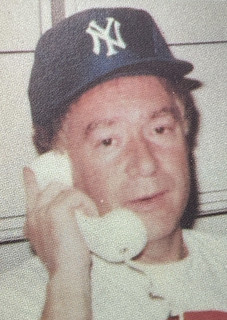 STANLEY KESSELMAN: So, it's now 1973. And Ted Naftzger calls. 1973 is a very bad year for the financial country.
STANLEY KESSELMAN: So, it's now 1973. And Ted Naftzger calls. 1973 is a very bad year for the financial country.
GREG BENNICK: Yeah, that's true.
STANLEY KESSELMAN: The Dow went from maybe 950 down to 480. The stock were paying nine and ten percent dividends because they were riskier than bonds. And we had a gasoline crisis. And Ted Naftzger calls, he needs money. He borrowed money from Wells Fargo. And I never heard of this before. Every three years from Wells Fargo, they made him repay the loan. And as soon as he repaid the loan, he can go out and borrow it all over again. The next day, the next hour, they just wanted to see he could repay it.
And it was 1973. And the cattle business was horrible. It costs more to feed the cattle than he could sell them for. So, he said he had to go sell his coins. So, I call Mike Brownlee up in Dallas. Michael had the customer to buy this. And Julian, since he was so nice to me over the years, I said, let's go to Beverly Hills. We'll meet Ted Naftzger. And we'll try and make a deal to buy his $20 gold coins. And Mike Brownlee brought his customer. His name was Jeff Browning. I don't know if you've ever heard of Jeff Browning.
GREG BENNICK: I have, yeah, I have.
STANLEY KESSELMAN: Jeff Browning was one of seven children. The parents died and they divided the land up into sevenths. They put in the hat the number of your lot. And he put their hands in the hat. The best lot was the one with the house on it. The other was all prairie and desert. So, Jeffery got the prairie and desert, but they discover oil on his land on the prairie and desert and Jeff Browning in 1973 was taking in around $450,000 a month. Which then was pretty big money.
GREG BENNICK: It's still big money, it's amazing.
STANLEY KESSELMAN: Okay, so he was the customer and he flew with Mike Brownlee to Beverly Hills. So, four of us were there, Julian, Mike Brownlee, myself and Jeff Browning. So, I take a room for Michael and myself, Julian has his own room and Jeff Browning has his own room. I'm the first one to arrive. I arrived there the room is freezing; the window had an air conditioner in it and the air conditioner was no longer there. So, you could not shut the window. So, I am totally freezing, the air's coming in, I get into bed and I’m wearing a suit with a tie. I go to sleep with my suit on, I loosen the tie.
So, there I am in the room, Mike Brownlee comes in later. He sees me sleeping there, he doesn't say too much. He takes off all his clothes and he sleeps absolutely nude. I didn't understand this at all, the room is freezing. So now I’m meeting Ted Naftzger downstairs in the coffee shop at nine o'clock, it's 8.30. He says, Kesselman, get out of bed you got to go shower and shave for this meeting. I'm still groggy, I said, “Don't bother me.”
So now it's five to nine, he's fully dressed he pulls the covers down off of me and I'm wearing my suit and tie. So, I look in the mirror, I tighten my tie and said Michael let's go. He couldn't believe I was fully dressed.
GREG BENNICK: That's amazing, I love that the reveal of you being fully dressed and ready for the meeting within 10 minutes, that's great.
STANLEY KESSELMAN: Right, I guess the smell didn't count, but off we went. So now Julian wanted to come to the meeting. I said, “You can't come,” because we'd be three against one and that doesn't look good. You stay in the room and we'll see what happens. So, Michael and I go to Ted Naftzger's office, he takes out he's only selling now his liberty $20 gold. He's keeping his St Gaudens.
GREG BENNICK: Got it.
STANLEY KESSELMAN: So, it's 1850 through 1907 and he has every coin which he’s upgraded. So, we had the calculators then, the first calculator made was a Bowmar Brain and that's what we had. So, Michael works it up and Ted Naftzger says he wants $250,000. Michael works it up on the Bowmar. He says, we can pay $175,000.
So, Michael works it up again. He comes up with $175,000. That's the most we can pay. Now, you have to remember, we had the buyer for this already in Beverly Hills in the hotel room. So Ted Naftzger says, “I'm not going to sell it less than $250,000. I took years to put it together, and I don't care, $250,000 is the price.” So, I said, “Michael, let me have the Bowmar Brain. Let me work it out.” And I stopped putting in numbers. I put in more numbers. I put in more numbers. And I say now, “I just figured out how to buy this set of gold coins.” And Michael Brownlee says, “Terrific.” And Ted Naftzger says, “Terrific.” So, Michael says, “How do we buy them?” I said, “It's simple. Pay the guy the $250,000.”
You know, we weren't going to leave, because we had the buyer there. So now everybody's happy. And we give him three checks, one from me, one from Julian, and one from Michael. And he gives us the coins. Michael takes the coins through Jeff Browning. And I think Jeff Browning gave us, I'm trying to remember the number. I think we made maybe $30,000 each, which was a hell of a lot of money back then. I never made $30,000 in my life in a deal.
And I came back to New York. And a few days later, Ted Naftzger calls. My check bounced. I didn't have enough money in the bank. He didn't care. I said, you know, go put it back. He put it in too soon. Whatever. I said, put it in again. And it cleared. But yeah. Well, Mike Brownlee and Johnny Rowe together had much more capital than I did. And Julian we owed a favor to.
And then the last part of the story is 1973 got so bad, he called, Ted Naftzger calls again and says he wants to sell the St. Gaudens 20s. He has to sell them. So, we go down. I said, “Julian, make your reservation. We're going back to Beverly Hills. Michael, make the reservation. We're going back to Beverly Hills.” And Jeff Brownlee came back to Beverly Hills. And we bought the St. Gaudens 20s. I think the 1927-D he did not have. We paid maybe $225,000 for them. St. Gaudens 20s.
But then he took out another coin. He says, I can sell you this one. And I open it up and it seems to be a 1933 $20 in maybe 65 grade. And I'm looking at the thing. I'd never seen one before. And he tells me he bought it from Abe Kossoff. He says he's not sure it's legal to own, which we understood. And he wanted $50,000 for it. So, we threw that into the deal.
GREG BENNICK: Wow.
STANLEY KESSELMAN: And we gave it to Jeff Browning and we told him he couldn't tell anybody about it. But he really wanted to own it. And he could definitely afford it. Because you're talking about two weeks’ money for him.
GREG BENNICK: Yeah. Amazing.
STANLEY KESSELMAN: I took the 1933 in my pocket for a while to have a good time. There was a coin convention out there at the time. And I'm sure you heard of Paul Nugget. And he was a big coin dealer in gold coins. He worked for MTB. And he worked for Stacks later on. And I showed the coin to him and he sort of went bananas. That he had it in his hand, the real 1933, twenty. Eventually the coin ended up with the government.
GREG BENNICK: And you were carrying it around as a pocket piece?
STANLEY KESSELMAN: Not for long. Maybe an hour in the convention room.
GREG BENNICK: All right.
STANLEY KESSELMAN: But eventually I think they surrendered the coin to the government after having it.
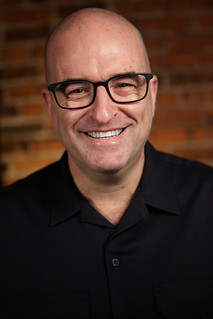 About the Interviewer
About the Interviewer
Greg Bennick (www.gregbennick.com) is a keynote speaker and long time coin collector with a focus on major mint error coins. Have ideas for other interviewees? Contact him anytime on the web or via instagram @minterrors.
To watch the complete video, see:
Stanley Kesselman Interviewed for the NNP by Greg Bennick
(https://nnp.wustl.edu/library/book/638521)
To read the complete transcript, see:
Stanley Kesselman Interviewed for the NNP by Greg Bennick (Transcript)
(https://nnp.wustl.edu/library/book/638520)
To read the earlier E-Sylum article, see:
STANLEY KESSELMAN INTERVIEW, PART ONE
(https://www.coinbooks.org/v27/esylum_v27n25a06.html)
SARAH SOPHIA BANKS
An article elsewhere in this issue announces a new book on the numismatic library of Sarah Sophia Banks. Here's an excerpt of a 2023 article about her by Catherine Eagleton, former Curator of Modern Money at the British Museum. -Editor
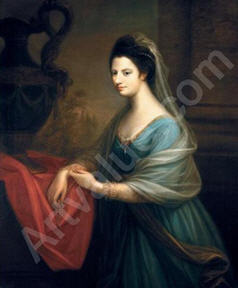 When Sarah Sophia Banks died in September 1818 – as a result of a carriage accident on returning home from dinner – her obituary in the Gentleman’s Magazine in November described her love of natural history, and explained that her collections had been presented to the British Museum. These collections, although less well-known than her brother’s huge collection of botanical and other specimens, were also extensive. From the 1770s onwards, she had collected coins, medals and tokens, as well as prints and printed ephemera, and the collections at her death numbered more than 30,000 objects. Now split between the British Museum, British Library, and Royal Mint Museum, they give us remarkable insights into the life and interests of Sarah Sophia.
When Sarah Sophia Banks died in September 1818 – as a result of a carriage accident on returning home from dinner – her obituary in the Gentleman’s Magazine in November described her love of natural history, and explained that her collections had been presented to the British Museum. These collections, although less well-known than her brother’s huge collection of botanical and other specimens, were also extensive. From the 1770s onwards, she had collected coins, medals and tokens, as well as prints and printed ephemera, and the collections at her death numbered more than 30,000 objects. Now split between the British Museum, British Library, and Royal Mint Museum, they give us remarkable insights into the life and interests of Sarah Sophia.
The numismatic collection included around 9,000 objects, as well as a large library. Sarah Sophia was particularly interested in collecting contemporary objects – a contrast to other collectors at the time, many of whom focussed on ancient coins. Joseph Banks, of course, was also interested in contemporary coinage, through his work on the Privy Council Committee on Coin, but his sister’s numismatic collection dwarfed his – he had only 100 coins and medals in it at his death.
ANA HONORS NUMISMATIC ROLE MODELS
Congratulations to the winners of this year's ANA awards. -Editor
Numismatic Role Models to be Recognized During Celebration Events at World's Fair of Money in Chicago
The American Numismatic Association (ANA) is recognizing leading role models in the numismatic community that have exhibited an influential, and positive presence. The Outstanding Adult Advisor and Outstanding District Representative will be awarded during the Chicago World's Fair of Money® Member Awards and Donor Celebration, Thursday, Aug. 8 from 3-4:30 p.m. in room 25/26 at the Donald E. Stephens Convention Center. The ANA Dealer of the Year will be awarded at the convention's 133rd Anniversary Awards Banquet, Friday, Aug. 9 from 7-10 p.m. in the Grand Ballroom at the Hilton Rosemont/Chicago O'Hare hotel.
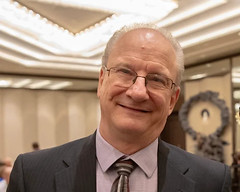 The 2024 Harry J. Forman Dealer of the Year is Richard "Rick" Snow. The award recognizes a professional numismatist who shows uncommon dedication to strengthening the hobby and the ANA; exhibits high ethical standards and integrity; and is committed to treating customers fairly and consistently.
The 2024 Harry J. Forman Dealer of the Year is Richard "Rick" Snow. The award recognizes a professional numismatist who shows uncommon dedication to strengthening the hobby and the ANA; exhibits high ethical standards and integrity; and is committed to treating customers fairly and consistently.
U.S. small cents of 1857-1909 are Snow's specialty. His concern for the collector is evident at his shop, Eagle Eye Rare Coins, in Tucson, Arizona. When they opened 32 years ago, Snow and his business partner began reevaluating cents graded by third parties. They attach a sticker to the holder of those they agree have the proper designation. This became the model for Certified Acceptance Corporation (CAC)'s "green bean" stickers.
DISPLAYS AT THE 2024 WORLD'S FAIR OF MONEY
The ANA World's Fair of Money® will be here before we know it. Here are some of the great exhibits to look forward to. -Editor
Multi-million-dollar exhibits of historic numismatic treasures, some on public display together for the first time, will be among the many highlights of the American Numismatic Association's (ANA) 2024 Chicago World's Fair of Money® (WorldsFairofMoney.com) in Rosemont, Illinois, August 6-10. ANA members are encouraged to pre-register for the show to skip the registration line. Pre-registration ends July 12.
 "The finest known 1794 Flowing Hair dollar, believed by many experts to be the first silver dollar struck by the young United States Mint, will be displayed for perhaps the last time for years to come. Insured for $15 million, it is going into a private collection after the convention," said ANA Executive Director Kim Kiick.
"The finest known 1794 Flowing Hair dollar, believed by many experts to be the first silver dollar struck by the young United States Mint, will be displayed for perhaps the last time for years to come. Insured for $15 million, it is going into a private collection after the convention," said ANA Executive Director Kim Kiick.
MIKE MARKOWITZ VISITS GREECE
Mike Markowitz recently visited Greece and prepared a presentation for the Ancient Numismatic Society of Washington, DC. He shared is with us for The E-Sylum. Thanks - great trip! -Editor
The Numismatic Museum of Athens is in the mansion built by Heinrich Schliemann (1822-1890) the discoverer of Troy.
ANCIENT COINS FEATURED IN ROBINSON AUCTION
Here's the press release for Frank Robinson's upcoming sale. Always some interesting material. See lots 585-610 for some numismatic literature. -Editor
Dealer Frank S. Robinson will conduct his 125th mail and internet auction of Ancient and Early Coins with a closing date of August 1. The sale will include 610 lots, low minimum bids, and bids to be reduced as competition permits. Robinson notes that reductions have averaged 15-20% in his recent sales. There is no buyer fee.
Featured in this sale is a further segment of a major collection of Judaean and Judaic related material, including some rare and important items, such as John Hyrcanus I Double Prutah with helmet, and a VF Vespasian “Judaea Capta” Sestertius
Greek coins include a slabbed EF Armenian Trigranes II Tetradrachm; several classic Athenian “Owl” tetradrachms in choice quality; VF Baktrian Tetradrachm of Eukratides I with heroic bust type; a rare Elymais silver Tetradrachm of Kamnaskires V in Choice EF; a good run of Parthian coins; and a rare EF Tetradrachm of Vadfradad I of Persis. There is also a special selection of the tiniest Greek coins.
Among Roman coins there is an AEF Pompey portrait denarius; an EF/AEF As of Agrippa and an EF/VF+ one of Caligula; a Port of Osta Nero Sestertius; an EF Faustina Senior Sestertius, and a Choice VF Sestertius of Maximus.
WAYNE'S NUMISMATIC LITERATURE RESULTS
Before the June 15 Kolbe & Fanning numismatic literature sale 170 I previewed several lots from the consignment of my own library. This week I'll circle back and review the prices realized. -Editor
Lot 303: Armand Champa Library Materials [Champa, Armand]. MATERIALS RELATING TO THE 1994–1995 SALES OF THE ARMAND CHAMPA LIBRARY.
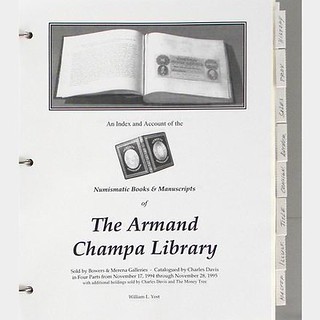 Two three-ring binders including the following: a postcard from George F. Kolbe announcing that he will be offering the Champa Library at auction; promotional materials for the November 1994 Baltimore show at which the first Champa sale was held by Bowers & Merena; the Bowers & Merena announcement of the Champa Library sale; Wayne Homren’s invoice for sets of both the softcover and hardcover catalogues; Homren’s annotated copies of the first two Champa sales, hand-priced and generally recording buyer numbers, some of which are identified; a copy of the Herman Halpern sale held March 24–25, 1995 alongside the second Champa sale; printed emails and other correspondence regarding the sales, between Homren and John J. Ford, Jr., Chris Karstedt and others; Homren’s bid card, handwritten notes, additional printed emails (Wayne was a trend-setter), Champa bookplates, lists of bidders, and so on.
Two three-ring binders including the following: a postcard from George F. Kolbe announcing that he will be offering the Champa Library at auction; promotional materials for the November 1994 Baltimore show at which the first Champa sale was held by Bowers & Merena; the Bowers & Merena announcement of the Champa Library sale; Wayne Homren’s invoice for sets of both the softcover and hardcover catalogues; Homren’s annotated copies of the first two Champa sales, hand-priced and generally recording buyer numbers, some of which are identified; a copy of the Herman Halpern sale held March 24–25, 1995 alongside the second Champa sale; printed emails and other correspondence regarding the sales, between Homren and John J. Ford, Jr., Chris Karstedt and others; Homren’s bid card, handwritten notes, additional printed emails (Wayne was a trend-setter), Champa bookplates, lists of bidders, and so on.
Also included is Bill Yost’s third draft and preliminary layout of his unpublished Index and Account of the Numismatic Books & Manuscripts of the Armand Champa Library (dated November 2, 1996). Materials generally fine or nearly so. A fascinating group of ephemeral items relating to the Armand Champa Library sales, accompanied by annotated catalogues and Homren’s notes made in preparation for, and immediately after, the sales. Included in the more ephemeral items are printed 1995 emails from the new BiblioNumis-L list being promoted by Harry Bass and Wayne Homren. Yost’s never-published work was envisioned to include a history of the collection, provenances, author and dealer index, consignor index, title index, index of illustrations, and a master index. Ex Wayne Homren Library.
A SILVER LIBERTAS AMERICANA MEDAL
I shrug when a common modern coin is touted as the "Finest Certified". But an historically important rarity is another story. Stack's Bowers Galleries Numismatist Chris Bulfinch wrote this short article about a wonderful silver Libertas Americana medal. -Editor
The Libertas Americana medal is legendary and, to no one’s surprise, it was chosen as #1 in the 100 Greatest Medals and Tokens book. Its classical imagery heralds the U.S. victory in the Revolutionary War and France’s role in the conflict. The profile of Liberty on the obverse and Minerva’s defense of the infant Hercules on the reverse are designs instantly familiar to students of early American numismatic history and have been reproduced countless times, using original dies and recreations of varying quality. Stack’s Bowers Galleries is proud to offer the sole finest PCGS-certified original 1783 Libertas Americana medal in silver in the August 2024 Global Showcase Auction.
Commissioned in 1782 to celebrate the fledgling United States’ victory over the British and the contributions of the French to the war effort, Libertas Americana medals were designed by Augustin Dupree and first produced in Paris in 1783. The concept and mottos displayed by this medal are attributed to Benjamin Franklin, who at the time was serving as U.S. commissioner to France. The obverse portrait would later influence some of the first renditions of Liberty to appear on United States coinage, specifically on the Liberty Cap copper coinage and the Flowing Hair silver coinage. The reverse design is highly symbolic, the two serpents representing the American victory over the British at the battles of Saratoga and Yorktown, but Minerva keeping the British lion at bay confirming that American independence would not have been possible without French aid. The dates in exergue on the reverse are the dates of the victories over General John Burgoyne at Saratoga and General Charles Cornwallis at Yorktown. The Original 1783 Libertas Americana medal is known in silver and bronze. Silver examples were presented to members of Congress, King George III’s government, and other notables and are rarer than the bronze versions.
PISTRUCCI'S WATERLOO MEDAL
Benedetto Pistrucci's Waterloo Medal is a pinnacle of numismatic art, with a long, tortured and celebrated history. The Royal Mint has issued a reproduction in its Great Engravers Collection. Their website has an article breaking down the major elements of the intricate work's design. -Editor
The development of the Waterloo Medal has been well documented, both through The Royal Mint’s archives and external sources. A design imbued with intricacy and ornate detail, it is understandable how it could take an artist three decades to perfect, especially one so committed to originality as Benedetto Pistrucci. However, there were external factors which influenced the painstakingly slow progress of the highly anticipated medallion. Despite assuming the responsibilities of Chief Engraver and carrying out many of the duties associated with the role, Pistrucci could never fulfil the role in an official capacity due to a law decreed by William III, which debarred a foreigner from assuming the position. His frustration was even more exacerbated when William Wyon RA, who once served as Pistrucci’s junior, assumed the role of Chief Engraver, with the Italian given the position of Chief Medallist. Embittered at what had occurred, Pistrucci played an active role in slowing the work on the medal to ensure his financial security, despite insisting to William Gladstone, then Master of the Mint, ‘it is impossible there can be in this world any one individual more anxious than myself, to see the Waterloo Medal finished.’
AUGUSTUS SAGE'S CYRUS FIELD MEDAL
Another article by Stack's Bowers Galleries Numismatist Chris Bulfinch discusses the Cyrus Field medal produced by Augustus B. Sage. -Editor
Augustus B. Sage is an important name in U.S. numismatic history. A cofounder of the American Numismatic Society, coin dealer, medal publisher, and veteran who worked in a variety of fields through his short life, Sage was one of the first prominent American numismatists in an era when the hobby was catching on in the country. He published medal series bearing his name beginning in the late 1850s through the 1870s. The first medallic appearance of his name came in 1858 when he published a medal, designed by George Hampden Lovett, honoring Cyrus W. Field, an American paper merchant and financier who spearheaded efforts to lay a transatlantic telegraph cable in the mid-19th century.
Cyrus Field joined the efforts to create a transatlantic telegraph in 1853, and on August 16, 1858 he sent the first official message across the wire. Queen Victoria and President James Buchanan exchanged transatlantic telegraph messages the same day.
FASCINATED BY OLD STOCK CERTIFICATES
This article by Peter Longini at the Pittsburgh Post-Gazette surveys the field of scripophily, the study and collecting of stock certificates. Here's an excerpt - see the complete article online. -Editor
OK, I’ll admit it. For some years now, I have been practicing scripophily. And for just as long, I have felt uncomfortable sharing that fact about my life with acquaintances.
To the ears of many people, it sounds like something that should only take place among consenting adults or as an activity that may not be legal in Florida. In any case, it isn’t something you routinely see people around you practicing. But I’d like to clear the air and get this matter off my chest.
Although I admit that its most passionate participants are all over 60, scripophily is actually a specialized collector’s interest, not an exotic fetish. It is a bit like stamp, coin or currency collecting, but it’s focused instead on stock certificates.
A VENDING MACHINE FOR MONEY
In the history-of-great-ideas department, here's the story of WWII vet John Shepherd-Barron, who dreamed up a vending machine for cash - the automated teller machine, or ATM. -Editor
After the war was over, Shepherd-Barron came home to the U.K., where he wound up in the management trainee program at a company called De La Rue Instruments. He worked hard, drew a paycheck, and formed a habit of cashing the check each Friday at the same time.
Then, one Friday in 1965, he was delayed, and he arrived at the bank one minute after it closed. Stuck without cash for the weekend, he went home, drew a bath, and contemplated his dilemma.
LOOSE CHANGE: JUNE 30, 2024
Here are some additional items in the media recently that may be of interest. -Editor
Dick Hanscom passed along this item on a judge's 300-year sentence for three murders in the commission of a coin shop robbery. -Editor
Alaska Superior Court Judge Jack McKenna sentenced Anthony Pisano, 50, to 300 years for the triple homicide in the Bullion Brothers store on Spenard Road in Anchorage on Sept. 12, 2017.
This was the maximum sentence allowable under the law and included three 99-year sentences for each murder victim and a five-year sentence for the assault of Michael Dupree, with two years running concurrently. The murder victims included Bullion Brothers store owner, Steven Cook, and residents Daniel McCreadie and Kenneth Hartman.
To read the complete article, see:
ANTHONY PISANO SENTENCED Counterfeit Banknotes in AustraliaTO 300 YEARS FOR 2017 SHOOTING DEATHS
(https://www.anchoragepolice.com/news/anthony-pisano-sentenced-to-300-years-for-2017-shooting-deaths)
Other topics this week include the 1884 Scottish Livestock Silver Medal, Part Two of Making the Peace Dollar, and counterfeit banknotes in Australia. -Editor


